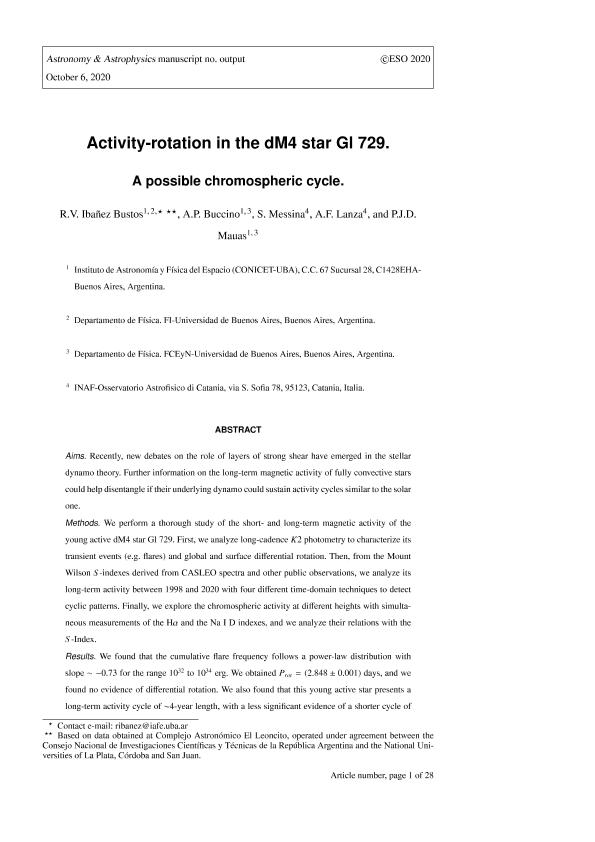Artículo
Activity-rotation in the dM4 star Gl 729: A possible chromospheric cycle
Ibañez Bustos, Romina Valeria ; Buccino, Andrea Paola
; Buccino, Andrea Paola ; Messina, S.; Lanza, A. F.; Mauas, Pablo Jacobo David
; Messina, S.; Lanza, A. F.; Mauas, Pablo Jacobo David
 ; Buccino, Andrea Paola
; Buccino, Andrea Paola ; Messina, S.; Lanza, A. F.; Mauas, Pablo Jacobo David
; Messina, S.; Lanza, A. F.; Mauas, Pablo Jacobo David
Fecha de publicación:
11/2020
Editorial:
EDP Sciences
Revista:
Astronomy and Astrophysics
ISSN:
0004-6361
Idioma:
Inglés
Tipo de recurso:
Artículo publicado
Clasificación temática:
Resumen
Aims. Recently, new debates about the role of layers of strong shear have emerged in stellar dynamo theory. Further information on the long-term magnetic activity of fully convective stars could help determine whether their underlying dynamo could sustain activity cycles similar to the solar one. Methods. We performed a thorough study of the short- and long-term magnetic activity of the young active dM4 star Gl 729. First, we analyzed long-cadence K2 photometry to characterize its transient events (e.g., flares) and global and surface differential rotation. Then, from the Mount Wilson S-indexes derived from CASLEO spectra and other public observations, we analyzed its long-term activity between 1998 and 2020 with four different time-domain techniques to detect cyclic patterns. Finally, we explored the chromospheric activity at different heights with simultaneous measurements of the Hα and the Na I D indexes, and we analyzed their relations with the S-Index. Results. We found that the cumulative flare frequency follows a power-law distribution with slope ~-0.73 for the range 1032-1034 erg. We obtained Prot = (2.848 ± 0.001) days, and we found no evidence of differential rotation. We also found that this young active star presents a long-term activity cycle with a length of about 4 yr; there is less significant evidence of a shorter cycle of 0.8 yr. The star also shows a broad activity minimum between 1998 and 2004. We found a correlation between the S index, on the one hand, and the Hα the Na I D indexes, on the other hand, although the saturation level of these last two indexes is not observed in the Ca lines. Conclusions. Because the maximum-entropy spot model does not reflect migration between active longitudes, this activity cycle cannot be explained by a solar-type dynamo. It is probably caused by an α2-dynamo.
Palabras clave:
STARS: ACTIVITY
,
STARS: LATE-TYPE
,
TECHNIQUES: SPECTROSCOPIC
Archivos asociados
Licencia
Identificadores
Colecciones
Articulos(IAFE)
Articulos de INST.DE ASTRONOMIA Y FISICA DEL ESPACIO(I)
Articulos de INST.DE ASTRONOMIA Y FISICA DEL ESPACIO(I)
Citación
Ibañez Bustos, Romina Valeria; Buccino, Andrea Paola; Messina, S.; Lanza, A. F.; Mauas, Pablo Jacobo David; Activity-rotation in the dM4 star Gl 729: A possible chromospheric cycle; EDP Sciences; Astronomy and Astrophysics; 644; 11-2020; 1-14
Compartir
Altmétricas



